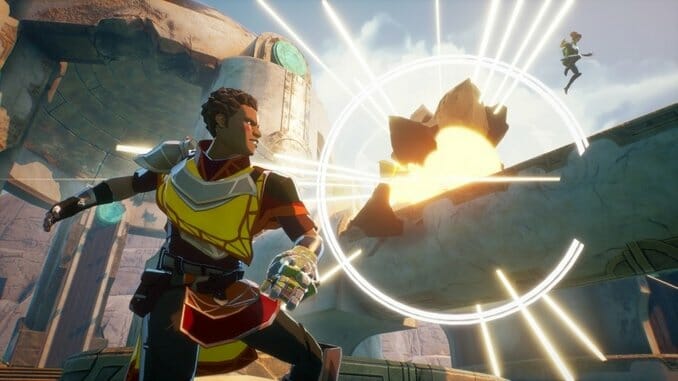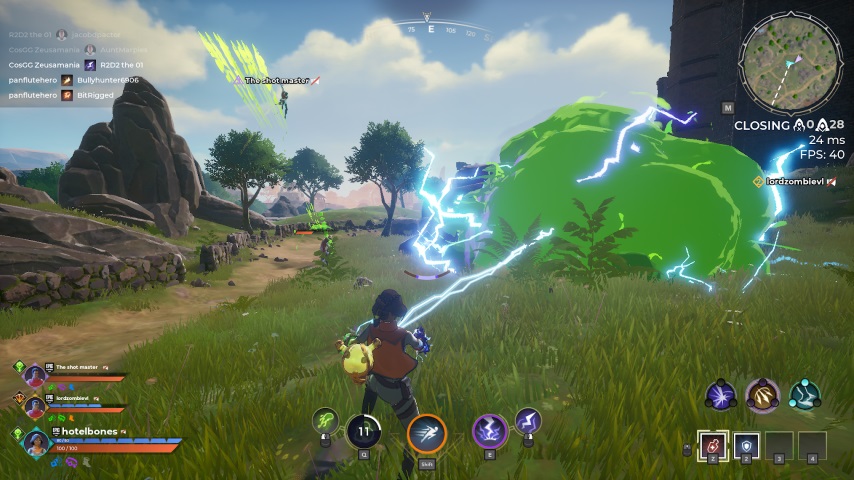Spellbreak Highlights the Real World Anxieties Stirred by the Battle Royale Genre

A match of Spellbreak plays out similar to many other battle royale games. You choose a spot on an island to drop onto, run through abandoned architecture, and hope that whatever conflicts happen you come out on top.
May the best, or in some cases luckiest, murderer win.
About a month ago I was hopeful when I started playing the magical battle royale. It distinguished itself from other genre entries with a magical setting and an art style that compared to a favorite animated series of mine, The Dragon Prince. The pieces were all in place for this to be the battle royale I stuck with after trying nearly 10 different others. However, as I played more I found that removing the grit and guns from this design only revealed that my issues with battle royales lied deeper than the aesthetics. The returning elements of disastrous landscapes and independent survival reminded me of many challenges our own world face today.
Spellbreak’s main selling point is magic. Instead of guns, players choose a magic type to enter into a match with as their main hand gauntlet, and then find other gauntlets to use as their off hand throughout gameplay. There are six types in total: air, earth, fire, ice, toxin, and lightning. The game utilizes these elements by having each projectile remain on the field in some capacity in order to interact with another element. For example, a toxin cloud can be hit with ice to become a large poisonous obstacle, and electricity can hit wind to create a lightning tornado.
The player also has passive abilities which allow them to interact with the elements in unique ways. The poison user can become invisible when walking into a cloud. The ice user can shoot frozone-like ice trails to skate faster to their destination. These interactions aren’t uncommon for the genre. Apex Legends gives characters abilities that create team and competitive dynamics as well. Alongside these abilities, Spellbreak stays true to the successful battle royale formula for the most part.

The map has been painted with the design of a theme park, each section harshly cutting between architectural and thematic cartoon styles. A broken down castle can become a cursed forest can become a burning desert. Players run around the map looking for armor, items, and weapons to plunder from buildings, seemingly abandoned for years.
While the new aesthetic on top of a familiar form of game may be comfortable for some, it also feels conflicted within these two values. In a world of colorful, lighthearted magic, the sole survivor design doesn’t sit well. In fact, it makes everything seem incredibly empty. Battles feel as if they would be better suited in a different competitive context rather than aiming to survive. Spaces not only neglect to provide reason for their existence, but it doesn’t even feel like a space that was made to be entertaining in the first place. Rather, it feels dead and sterile, like someone looked at you like a child, handed you a spoon and said, “you are a wizard in a vast fantasy world!”, then left the room.
As I kept playing matches with friends, a question grew more prominent in my head. When did battle royales become the goal unto themselves?
As Dante Douglas wrote two years ago, many come to battle royales for the thrill of being the carnivorous dominator in a “one man against the world” scenario. Yet, Spellbreak has removed the spectacle of gritty survival with color and heart. Along with this, the formula of battle royale being familiar only makes the absurdity of the goal more apparent. The veil of the spectacle falls, and a confusing, nonsensical juxtaposition of elements remain.
Spellbreak doesn’t make you feel like a wizard, it makes you feel like a soldier with cartoon gun hands. There is no attempt to move away from the carnivorous dominator design. And as a result, the ideologies of shoot and loot meritocratic conservatism is veiled underneath cartoon violence and magic.
It isn’t really new to criticize a game for internalizing forms of violence through various historically repeated designs. However, within battle royales there are ideals that specifically arise from our contemporary modes of violence that become more apparent when a less cohesive game like Spellbreak comes to form.
PUBG set the standard of players all dropping into an island that was ruined, fighting for each other’s lives with only the ability to trust a friend, maybe two. Then all players ran through environments of broken down shelters and forgotten military bases to find weapons of survival.
Leading into the development and release of PUBG and up through today, the amount of disasters in the world increased. Shootings in the US rose in 2015 to now with a mass shooting event happening nearly every 47 days. The Pulse nightclub, the Las Vegas music festival, the store in El Paso, Stoneman Douglas High School: These are only some of the locations of countless horrible events reoccurring in the country.
Alongside these shootings, the later 2010s have been a constant whirlwind of natural disasters. Between 2015-2019, NOAA Climate.govestimated that natural disasters have caused $69 billion of damage in the U.S. alone. The organization notes that this amount of events are particularly increased from previous years along with the average cost of damages. In short, the amount of disasters we are experiencing are increasing. Many members of the younger generations are aware of this. In some ways this anxiety emerges as liberal cynicism that the system is broken and there is no solution. In other ways, activists are coming together to call for drastic ecological change, or even revolution.

These battle royales do not explicitly reference these events, but what we consider to be fun is constructed from the material and social elements of our cultural experience. Considering these increasingly common traumatic events, the battle royale is essentially a genre that gives players the agency to control the violence and safety within disastrous and violent spaces. The destroyed ruins of houses and military bases can be survived. Every shooter can be brought down through the player’s own power. No longer is the trauma of 9/11’s neverending war at the top of our anxiety. Now the younger generation incites a growing liberal anxiety of helplessness at the end of the world. So we drop onto ruined islands, without any hope of rebuilding, and instead pick up guns to make sure we are the only ones who can continue surviving.
Communities, internalized skills, and personalities form around these anxieties in the form of play. In the same way that military games trained players to be familiar with the mindset of a soldier, battle royales familiarize player bases with the language, mindset, and strategy of the autarky. Our ears become trained to listen for any sound that could indicate our death. Our minds become callous to the nameless ruins we plunder.
And maybe this is why I find Spellbreak so dull. When the spectacle of intensity is washed away, all I see is a digital landscape of misled liberal fantasy. While the world needs more unified action between the people than ever, I find this repeated formula very trite in response.
When we can allow ourselves to fantasize about being magical gun wielding wizards, we still can’t imagine a world where things can work towards caring and healing. There is only kill or be killed.
Waverly is a trans game artist and freelance writer. She has written at Uppercut, Into The Spine, and Fanbyte. You can find her on Twitter @hotelbones.